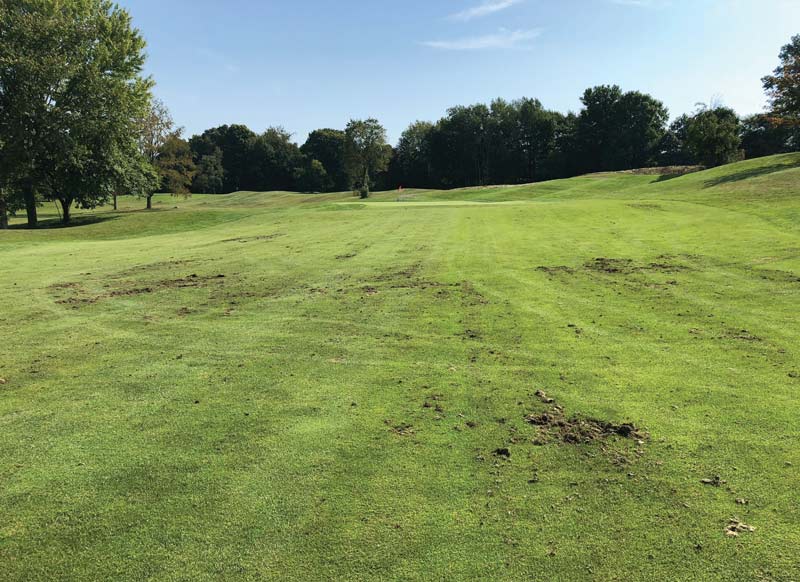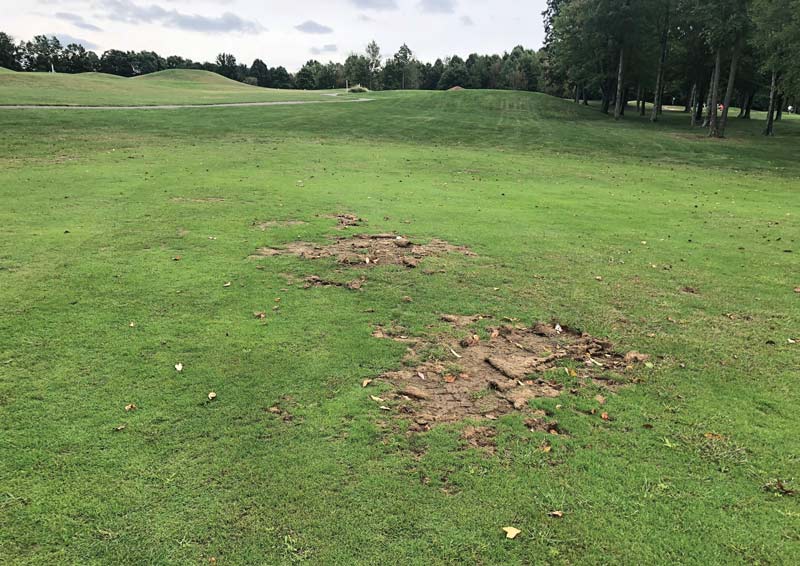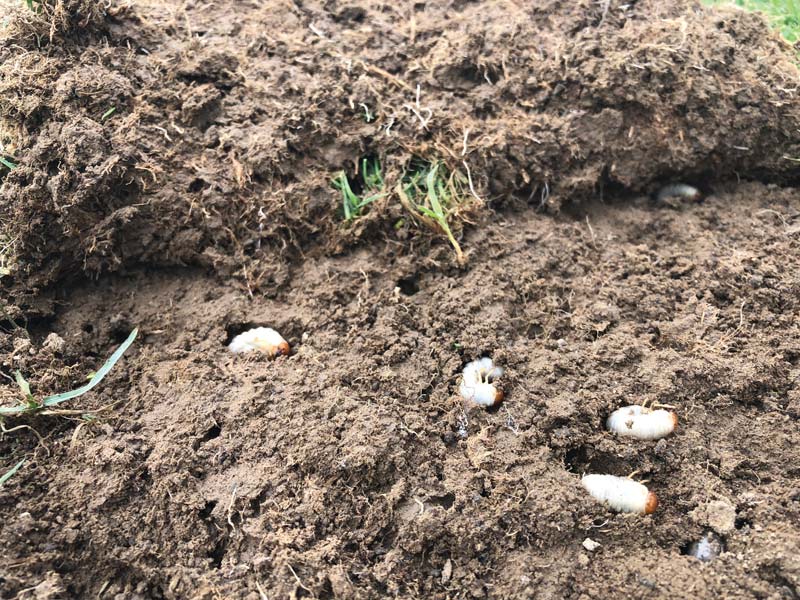
By using preventive insecticide applications, superintendents can control white grubs before they can damage turf roots. Besides killing the turf, grub damage attracts small mammals such as skunks and raccoons that cause further destruction in their attempts to find the insects. This photo shows damage from both the grubs and the mammals that are their predators. Photos by Ben McGraw
Neonicotinoids, particularly products containing the active ingredient imidacloprid, have been relied upon heavily by turfgrass managers over the past three decades to control white grubs. Imidacloprid’s relatively long half-life in soil and acropetal movement through the xylem allow turfgrass managers to control white grubs preventively, rather than waiting until the root-feeding larvae — or possibly even turfgrass damage — are apparent. Compared with older broad-spectrum contact insecticides that provide only moderate control, imidacloprid can provide high levels of control with a single application per growing season.
However, recent reports from some turf managers in the northeastern United States have indicated that imidacloprid has failed to provide adequate suppression of grubs in areas where superintendents have applied the active ingredient on an annual basis for more than 10 years. Other similarities in reports include greater grub densities in the rough than in adjacent fairways.
Although many factors may affect insecticide performance, our studies focused on whether imidacloprid efficacy was affected by thatch and whether soil microbes were responsible for prematurely degrading the active ingredient.
Cases of imidacloprid breakthrough
Five golf courses in New York and Pennsylvania that had reported imidacloprid breakthrough in the fall of the previous year were included in the spring study. Each course had applied imidacloprid on a calendar basis for more than 10 years, had never applied other preventive white grub products, and had observed damage in an imidacloprid-treated rough-fairway area in fall.

Raccoons were able to roll up sections of this fairway because white grubs had been feeding on the turfgrass roots.
Study areas consisted of 400 1-square-foot plots arranged in a 40-foot × 40-foot square, with equal parts rough and fairway. Turfgrass species and thatch thickness were recorded before destructively sampling for white grubs.
The spatial distribution of white grubs, turfgrasses, thatch thickness and the associations between spatial patterns (for example, white grubs:thatch thickness) was characterized using Spatial Analysis by Distance IndicEs (SADIE) freeware. In addition, soils were removed from the densest grub plots in the fairway and rough and assayed to determine whether microbes prematurely degrade imidacloprid. Each soil sample was divided into sterilized (to remove soil microbes) and non-sterilized treatments, then seeded with perennial ryegrass. Imidacloprid was applied at label rates once plants were mature, and concentrations were measured in the plant up to 56 days after treatment using an enzyme-linked immunosorbent assay (ELISA) kit.
Results
Significant differences in imidacloprid concentrations were detected between sterilized and non-sterilized treatments at 28 days after treatment, indicating that microbes contribute to product degradation. However, despite statistical differences, the numerical differences were small (~5-10 ppb) and unlikely to lead to differences in control or to be a sole factor in the reduced field efficacy.
A concurrent field study aimed at examining residual imidacloprid concentration over time also casts doubt that imidacloprid residual activity is compromised, as we observed relatively stable concentrations in roots for more than 80 days after treatment.

White grubs and thatch are often found together in golf course rough.
Spatial analyses of affected field sites revealed that white grub spatial patterns in imidacloprid-treated areas were significantly associated with those of turfgrass species (Kentucky bluegrass, perennial ryegrass) and thatch thickness at three of four sites (those with enough grubs to perform analyses). White grubs were significantly aggregated at four sites, and thatch was significantly aggregated at five. Greater grub densities and thicker thatch levels were observed in the roughs at all sites with significant aggregations.
Although theses analyses do not directly assess the influence of thatch on insect abundance or distribution, the strong associations between thatch and white grub spatial patterns suggest that elevated thatch levels create conditions leading to either greater grub densities (for example, preferred beetle oviposition sites) and/or negatively affect insecticide performance.
We hope that ongoing studies examining the effect of imidacloprid translocation throughout the plant with different thatch levels provide a better understanding of the relationship between thatch and insecticide performance.
Andrew Huling is a graduate student in turfgrass science, and Ben McGraw is an associate professor of turfgrass science in the Department of Plant Science at Penn State University, University Park, Pa.